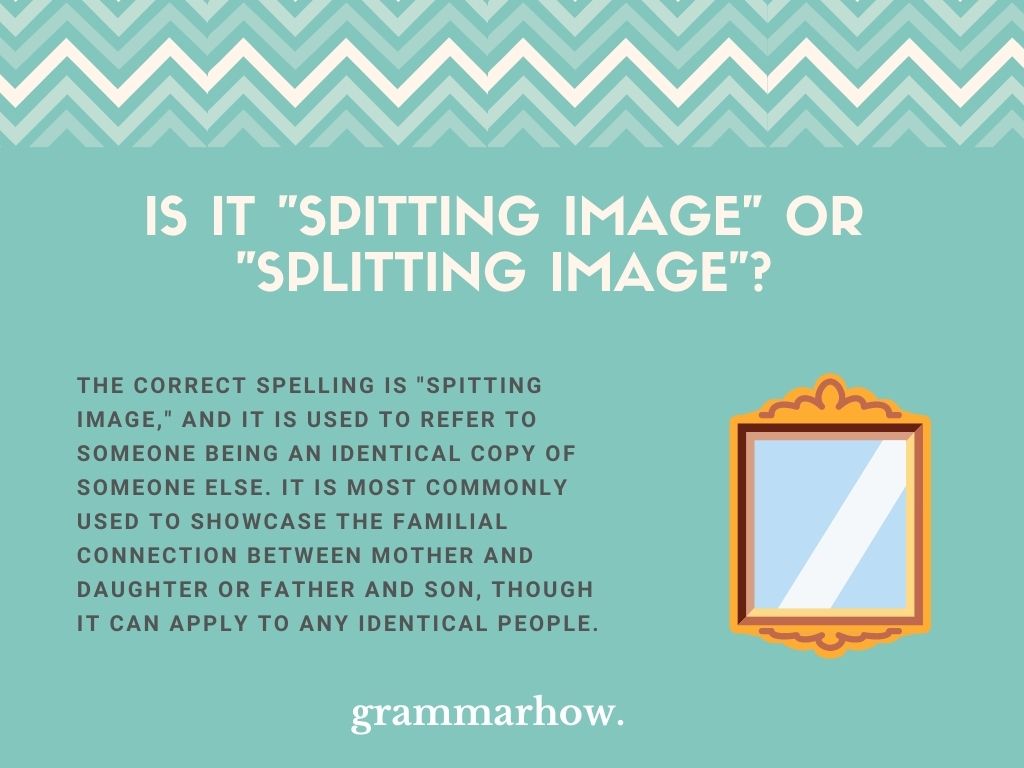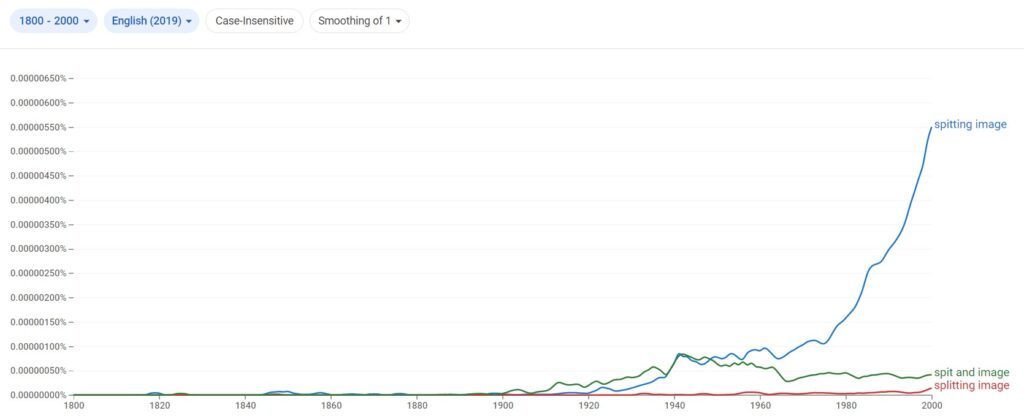Common phrases and saying are part of what makes the English language so interesting to learn. Over the years, different idioms and phrases develop into things that might not make sense. Take “spitting image,” for example. Some people believe it should be “splitting image,” but let’s see why it isn’t.
Is It Spitting Image Or Splitting Image?
The correct spelling is “spitting image,” and it is used to refer to someone being an identical copy of someone else. It is most commonly used to showcase the familial connection between mother and daughter or father and son, though it can apply to any identical people.

According to The Cambridge Dictionary, there is no such thing as a “splitting image.” Instead, we should use “spitting image,” as it means “to look extremely similar to someone.”
How Common Is The Use Of “Splitting Image” And Is It Accepted?
“Splitting image” is an example of the idiom being taken out of context and applied differently. People believe that since most people talk about someone being identical to someone else, it’s almost like a picture has split in two to make two different people. However, “splitting image” is an incorrect usage of the phrase.
If you refer to this graph, you can see how popular “spitting image” is compared to “splitting image.” Generally, people will use “spitting image” correctly when referring to someone looking almost identical to someone else.

Something can be said for the plausibility of “splitting image,” though, which shows why it slowly started to develop in usage in the 2000s. Most people still use the original saying “spitting image,” but don’t be surprised if one day “splitting image” becomes the more correct way to use the phrase.
It happens to a lot of idioms and sayings over the years. There are plenty around that has evolved past the original point that we thought they’d stay at. A good example is “should have” and “should of.” “Should of” isn’t a correct phrase, but it’s becoming the more widely known and accepted version. One day soon, the same might be said about “splitting image.”
Why Does It Make Sense That It Should Be “Splitting Image”?
So, what makes “splitting image” a somewhat popular variation? Well, people look at the context of the meaning and believe that it must work in some way. If you think about it, splitting an image in two rather than “spitting” on an image to create a copy does make more sense. But, let’s elaborate for you.
When two people look alike, people believe an image of one of them has been split into two. That’s why “splitting image” makes more sense. It’s also the reason why one day, “splitting image” will probably be the more popular choice of the phrase.
Many older people who remember the traditions and origin of the saying are used to using “spitting image.” However, for the younger generation, it might not have been as keenly taught. That’s why some people can get it wrong – and why it’s inevitable that one day the saying “splitting image” will most likely be the popular one.
For now, “spitting image” is the only correct way to use the saying. You can also say “spit and image,” which is an even earlier iteration of the saying. However, “splitting image” is still not correct, and you shouldn’t use it if you can remember these rules.
What Does Spitting Image Mean?
“Spitting image” means that two people look identical to each other. The people aren’t relevant, as long as they look the same.
For example, it can refer to a daughter looking like her mother, but it can refer to a young man looking like a well-known celebrity. If you or someone you know looks like somebody else, they are considered to be some level of “spitting image.”
The saying “spit and image” is also relevant. The idea originally refers to a familial connection and is said that a father (or mother) spat, and their child came out looking exactly like them. That’s the origin of the saying, but we’ll touch on that a little bit more later on.
Examples Of How To Use Spitting Image In A Sentence
Now let’s look at some examples of when the saying might be used more commonly. We’ll include a few different examples to cover as many ideas as possible.
- His son is the spitting image of him.
- Has anyone ever told you that you are the spitting image of Elton John?
- You two are the spitting image of each other! How are you not related?
- Wow, you must be sisters! You’re the spitting image of each other!
- People tell me that I’m the spitting image of my father.
When we write “spitting image,” it’s always preceded by the word “the.” We don’t use “a spitting image” because it’s implied that this image is the one and the only image being talked about – hence why “the” is the optimal word to show its uniqueness of it.
We can write about someone being the “spitting image” of another person, even if they don’t look exactly alike. Since when you’re talking about somebody’s looks, you’re talking about a subjective and qualitative feature; everyone perceives everybody else’s look differently.
What Is The Origin Of Spitting Image?
So, where did “spitting image” come from? We can actually strip the word down to its bare minimum features and show you the first appearances it made in the world. Perhaps that will shed more light on why it’s “spitting image” rather than “splitting image.
The Original Metaphor
The original metaphor is dated back to 1689 and was quoted as “it’s like he was spat out of his father’s mouth.”
To help clarify the meaning of that, imagine somebody looking exactly like their father. Now imagine the metaphor that might come from it. Saying that a son was spat out of his father’s mouth means that he came directly from his DNA.
It indicates that there’s no real difference between the two men, and they are identical. This original metaphor led to the later creation of “spitting image,” but we’ll get to that. Hopefully, that’s all the clarification you needed, and now the rest of the pieces of the puzzle will fall into place!
Metonymy
Eventually, the original metaphor became a very well-known and well-used phrase. That’s when the metonymy portion of its evolution starts to kick in. Metonymy is where you omit or substitute parts of a phrase to hold the same meaning still and become a widely accepted phrase instead.
The metonymy for the original metaphor was “he’s the very spit of his father” and first appeared in 1825. Now, we no longer need to include anything to do with coming out of the father’s mouth. It shows the next evolutionary step of the saying.
Idiom
The idiom comes out of the phrase when people hone in on the meaning of the metonymy. This means they work it down to the point that it is widely accepted by the general population, and now everybody understands what it means.
In 1859, “the spit and image of his father” was the new idiom and was what most people stuck with. If you say “spit and image” aloud, you may start to understand where we go next. It already closely resembles the phrase “spitting image.”
Corruption
The next step in any idiom’s evolution like this involves corrupting the original idiom or metaphor. Since we’ve currently got “spit and image,” it was only a matter of time before people started to look for quicker options to say and write it.
That’s where the corrupted phrase “spitten image” came from. It was first used in 1878, but that’s about all we know about it. It wasn’t the most common way to use it, and “spitten” isn’t a recognizable word, but that was what started the transition nonetheless.
The Final Saying
Finally, we’re introduced to the saying “spitting image” in 1901. It took a few decades, but “spit and image” and “spitten image” were eventually left to the language’s history and paved the way for “spitting image” to come about.
Since its arrival in 1901, it’s still the most common way to say that two people or things look almost identical to each other. It shows how popular the saying is, considering it’s been around for over a century and “splitting image” still hasn’t found a way to remove it from the pedestal.
However, the final step in any idiom or phrase evolution like this is to continue analyzing it until the most plausible explanation is used for its meaning. Since “splitting image” comes with a very plausible explanation of its own (explained earlier in the article), it’s no surprise that one day, “splitting image” might overtake in popularity.
The most likely result is that “spitting image” and “splitting image” will be about as popular as each other and will be used interchangeably. Still, it’s all about personal preference and which you prefer to use.

Martin holds a Master’s degree in Finance and International Business. He has six years of experience in professional communication with clients, executives, and colleagues. Furthermore, he has teaching experience from Aarhus University. Martin has been featured as an expert in communication and teaching on Forbes and Shopify. Read more about Martin here.
